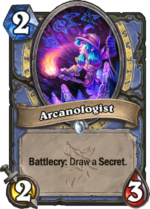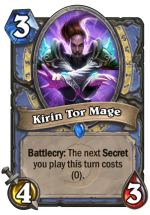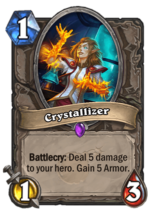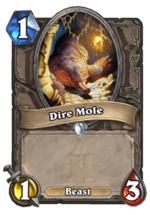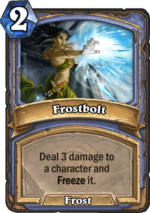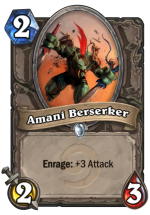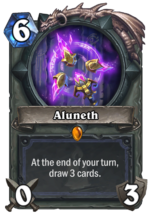Mulligans
General Mulligans
Against every deck, keep:
Dire Mole/Crystallizer
- you want to open every game with a 1-drop, no matter if you're facing
a fast deck or a slow one. Crystallizer is slightly better to play
earlier, as it becomes unplayable when you have 5 or less health, but
that's irrelevan in most cases.
Arcanologist - Your best 2-drop in the deck. You want to play it on turn 2, especially if you have a Kirin Tor Mage to follow up, but you can also keep double 2-drop if you're on the Coin and play Coin into Arcanologist on turn 1.
Kirin Tor Mage
- ideally, you want to keep this card with a Secret or Arcanologist,
but if your early curve is strong enough, you may as well keep the Kirin
Tor Mage as a well-statted 3-drop.
Aggro Mulligans
In aggressive matchups, you might also keep:
Amani Berserker - against decks that run multiple 1-Attack minions, this is usually a better card to play on T2 than Arcanologist. For example, against an Odd Rogue, this can clean up a Fire Fly and threaten a Hench-Clan Thug, and many opponents would hesitate from swinging with their dagger into a 5-Attack minion.
Frostbolt - you can keep this against
decks with high-priority early game minions. Removing a Flame Imp from a
Zoolock's early board is strong, especially if it threatens your Mole
or Crystallizer, although you only keep Frostbolt if the rest of your
hand is good as it's a rather slow card compared to like Arcanologist or
Amani.
Control Mulligans
Against slow decks, you might also keep:
Aluneth - your
late-game card draw engine and main win condition against slower decks
is a good keep if the rest of your opener is strong. Always keep if
you're on the Coin and aim for playing this card as soon as possible,
ideally on T5.
Introduction to ‘Good Old’ Tempo Mage
My favorite deck ever was Tempo Mage back in KnC, so here I am with a remake of the deck a year later. I tried to make it as similar to the KnC deck as possible, so let me explain some of the card choices:
Dire Mole – replaces Mana Wyrm (R.I.P friend [*], you’ll be missed). While not being nearly as strong as Mana Wyrm, a 1/3 is still good to get on T1.
Crystallizer – I found no direct replacement for Kabal Lackey, so I decided to put another well-statted 1-drop into the deck. You could also try Fire Fly or Glacial Shard.
Amani Berserker – a replacement for Medivh's Valet; it might be much weaker overall, but is better played on T2, can be pinged with your HP for more damage, and doesn’t require any setup to be played. You could also try Spellzerkers, but in a build with no Shooting Stars and stuff, Amani feels much better.
Ethereal Arcanist/Spellbender – Arcanists replace Kabal Crystal Runners, and Spellbender replaces Ice Block. Spellbender is the easiest of the three secrets included to stick to the board, and is really good followed by the Arcanist on T4. The secret itself can give you some value too, especially against decks like Even Paladin.
Pyroblast/Harrison Jones – same thing like with the Lackeys, there is no replacement for Firelands Portal, so I decided to put that extra burn into the deck, as well as a good anti-weapon tech in form of Harrison.
‘Good Old’ Tempo Mage Play Strategy
VS Fast Decks
In aggressive matchups, the most important thing is your early curve. The best possible scenario is Dire Mole/Crystallizer into Arcanologist into Kirin Tor Mage with the Secret you’ve drawn with the Arcanologist, and if the Secret manages to ‘stick’ you ideally play Ethereal Arcanist on T4. You basically can’t afford to fall behind in any way, as the deck is not very board-oriented and if it gets outvalued by something like Odd Paladin, it has hardly any ways to come back.
Your Secrets, specifically Explosive Runes are really important in these matchups. The Runes wreck like any minion without Divine Shield your opponent can play early, but sometimes Counterspell or even the Spellbender is more advisable. For example, if you are fairly ahead, you have an Ethereal Arcanist in your hand and you have to choose between Explosive Runes and Spellbender, you might consider the second one as a ‘sticky’ activator for the Arcanist next turn. Nevertheless, Runes are better in most cases, and can really help controlling the board.
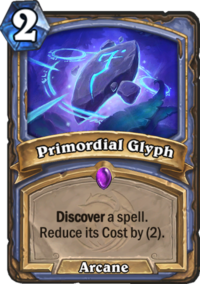 As the deck runs no AoE spells, it’s even more important to control the board with minions, although here is where the Primordial Glyphs sneak in. Discovering something like a Blizzard and playing it on turn 4 can be massive, but the Glyph itself loses you some tempo so it’s advisable to play it alongside Sorcerer's Apprentice. Other good cards to Discover include Dragon's Fury (always deals at least 2 to everything with a high chance to deal more), Flamestrike or even Arcane Explosion, Blast Wave or Shooting Star.
As the deck runs no AoE spells, it’s even more important to control the board with minions, although here is where the Primordial Glyphs sneak in. Discovering something like a Blizzard and playing it on turn 4 can be massive, but the Glyph itself loses you some tempo so it’s advisable to play it alongside Sorcerer's Apprentice. Other good cards to Discover include Dragon's Fury (always deals at least 2 to everything with a high chance to deal more), Flamestrike or even Arcane Explosion, Blast Wave or Shooting Star.
As your main goal in this kind of matchups is to survive, you would rather use your burn spells to control the board, especially if you’re already ahead with minions. Your Fireballs can remove basically any mid-sized threat such as Hench-Clan Thug, and Frostbolts can clear for example a Flametongue Totem. Sometimes it might feel bad to like waste a Fireball on something small such as Lightwarden, but there are cases in which it’s the best possible play.
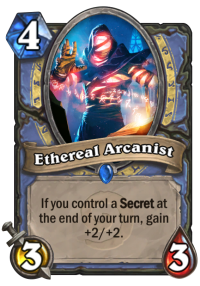 As the game goes on, your opponent will probably be running out of resources. Here is where you switch your gameplan to burn damage. The super-important card here is Aluneth – if your opponent has hardly any resources and you play it, the game is basically over. You no longer focus on board control and placing minions, but instead pressure the face with your Fireballs and Pyroblast. Also, this is the time when Ethereal Arcanists start to shine, as your opponent has a lower chance to have a trigger for your Secrets and the Arcanists grow extremely fast.
As the game goes on, your opponent will probably be running out of resources. Here is where you switch your gameplan to burn damage. The super-important card here is Aluneth – if your opponent has hardly any resources and you play it, the game is basically over. You no longer focus on board control and placing minions, but instead pressure the face with your Fireballs and Pyroblast. Also, this is the time when Ethereal Arcanists start to shine, as your opponent has a lower chance to have a trigger for your Secrets and the Arcanists grow extremely fast.
VS Slow Decks
Slower, control matchups are very different from the aggressive ones. Since your opponent most likely has a small amount of early-game plays, such as a Big Spell Mage has, the early curve is not that important, but it’s still something that you focus on. You should try to maximize the early pressure with cards like Kirin Tor Mage or Ethereal Arcanist to switch to a complete face-burning plan later. You might choose to take a completely aggressive route – for example, ignore a Northshire Cleric and go face with your Kirin Tor Mage, but if you have a good value trade available – like going with your Arcanologist into an enemy Fire Fly – I would rather go for it.
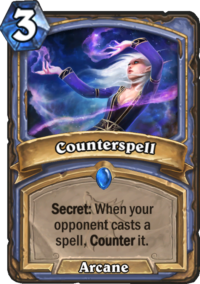 When it comes to your Secrets, if your opponent doesn’t have the Coin, Counterspell is probably the most advisable choice. Denying an early board clear such as a Hellfire can win games, but even getting rid of a Wandering Monster or some removal can be very good. Spellbender is usually better to play against Paladins than Counterspell – redirecting their Blessing of Kings or ideally Spikeridged Steed is devastating in most cases. However, some slower decks are more minion-based – the perfect example is Even Warlock – and you would prefer to play Explosive Runes against them, not to mention that the Runes are always better if your opponent has the Coin.
When it comes to your Secrets, if your opponent doesn’t have the Coin, Counterspell is probably the most advisable choice. Denying an early board clear such as a Hellfire can win games, but even getting rid of a Wandering Monster or some removal can be very good. Spellbender is usually better to play against Paladins than Counterspell – redirecting their Blessing of Kings or ideally Spikeridged Steed is devastating in most cases. However, some slower decks are more minion-based – the perfect example is Even Warlock – and you would prefer to play Explosive Runes against them, not to mention that the Runes are always better if your opponent has the Coin.
Your main win condition is slow matchups is burn damage. Here I have to mention that Odd Warrior is almost an unwinnable matchup because even if they draw really bad, the 4 Armor every turn usually does the job. Same goes for Quest Priest – if you don’t pressure them hard enough, Amara, Warden of Hope is game over for you. However, as your deck has a total of 28 burn damage in spells, with some early minion pressure this should be enough against lots of matchups. With Druid leaving the meta nearly completely, you shouldn’t worry about this being not enough, but if you face lots of Odd Warrior, I’ll recommend switching to a different deck.
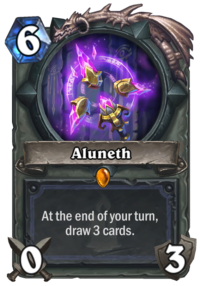 The main win condition in those matchups is definitely Aluneth. Drawing four cards a turn is massive and lets you find your burn really quickly. You can afford to sacrifice a lot of tempo to play the weapon on T6 or T5 with the Coin, and after you have it, you will never run out of resources. Keep in mind though that lots of decks run weapon removal in this meta, and destroying your Aluneth is extremely bad for you. That’s why you want to find it as quickly as possible, even keeping it in your opening hand, and hope that your opponent wouldn’t find their tech. Cards that can help you here are Arcane Intellects and even Harrison Jones.
The main win condition in those matchups is definitely Aluneth. Drawing four cards a turn is massive and lets you find your burn really quickly. You can afford to sacrifice a lot of tempo to play the weapon on T6 or T5 with the Coin, and after you have it, you will never run out of resources. Keep in mind though that lots of decks run weapon removal in this meta, and destroying your Aluneth is extremely bad for you. That’s why you want to find it as quickly as possible, even keeping it in your opening hand, and hope that your opponent wouldn’t find their tech. Cards that can help you here are Arcane Intellects and even Harrison Jones.
If you have your Aluneth equipped, you should avoid overdrawing, as losing a Pyroblast, for example, could lose you the game if you don’t have the finishing blow to your opponent’s face. Make good use of your Sorcerer's Apprentices and try to avoid playing Arcane Intellects and Harrison if your opponent has a weapon. Keep in mind that Fatigue is a thing, and you have no Ice Block to hide behind. That’s where Primordial Glyphs come handy; you can get extra burn, even a second Pyroblast, some stall cards like Ice Barrier or Frost Nova, or a draw engine/value generator such as Arcane Intellect or Blast Wave. Nonetheless, in most control matchups it is advisable to choose the burn if possible.
‘Good Old’ Tempo Mage Card Substitutions
The deck isn’t super expensive and would probably work as a budget version, although I haven’t tested it, but there are some cards that you might not have.
- Aluneth – I would say this one is absolutely necessary. It’s your main win condition in a LOT of matchups, and there aren’t any cards that can replace it.
- Harrison Jones – useful, albeit not necessary. If you really want that weapon tech, I would go for a Gluttonous Ooze or a more budget Acidic Swamp Ooze, but you can also try Cosmic Anomaly or Cinderstorm for extra burn damage, or maybe even Stargazer Luna if you have her.
- Crystallizer – 1/3 are very good stats on a 1-drop, but if you don’t have this card, you can go for Glacial Shards, Fire Fly or even Saronite Taskmaster, although I don’t like this particular one.
- Primordial Glyph – this is the most important epic here, serving as a great value generator and the only way to get some AoE pieces. However, it can be replaced with a 2-drop, and cards like Mana Addict or even post-nerf Mana Wyrm work well here.
- Spellbender – used mainly to activate Ethereal Arcanists as a ‘sticky’ Secret, but not really necessary. Replace with another Secret such as Mirror Entity, Mana Bind or Splitting Image if you have one.
- Pyroblast – a rather important one; helps in closing out games, but can be subbed with some mid-game card like Cobalt Scalebane or even something like The Lich King or Alexstrasza.
Hope you enjoyed the guide and the deck. Write your opinions in the comments below.

















/rating_1_half.png)
/rating_2_off.png)
